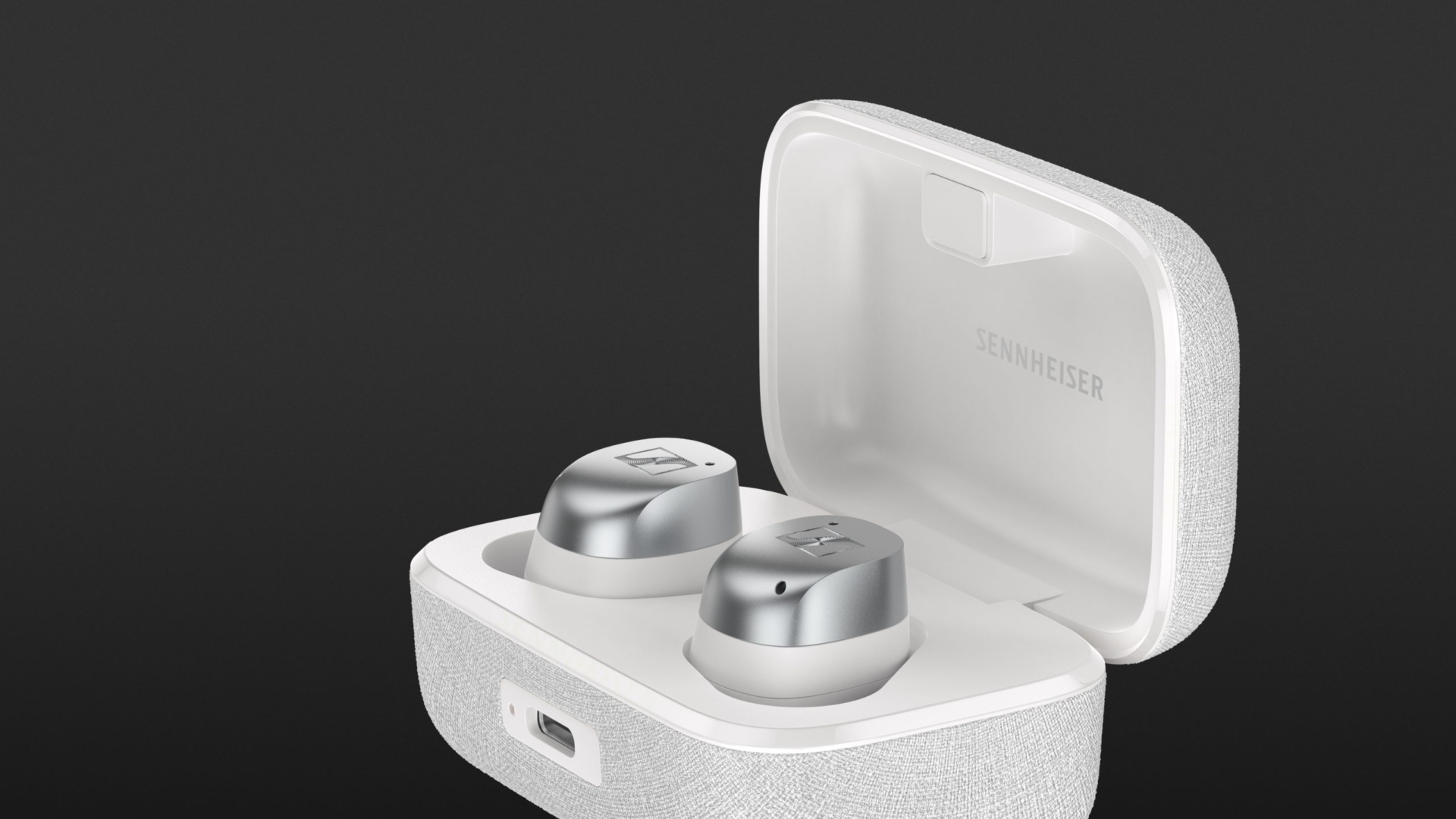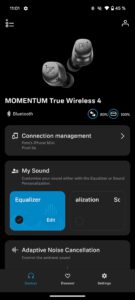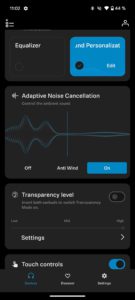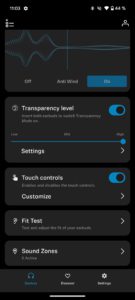The Sennheiser Momentum True Wireless 4 boast very good noise cancelling and harmonious sound. The manufacturer is also equipping these new in-ears for the future: thanks to the latest Qualcomm chipset, they now work with Bluetooth version 5.4 and expand their area of application enormously thanks to Auracast support.
- Very good sound
- Effective noise cancelling
- Bluetooth 5.4 incl. Auracast
- High-quality codecs with aptX Lossless and LC3
- Multipoint
- Background noise of the transparency mode at the highest level
- Operation partly illogical
- Still some bugs in the interaction between the app and the headphones
The Sennheiser Momentum True Wireless are among the most successful wireless in-ear headphones of recent years. This was demonstrated by our review of the previous version, which was one of the most-read articles on our website. Now the German manufacturer has launched version 4. With revised noise cancellation and many clever features, Sennheiser wants to build on its success. Will they succeed?
Look and feel of the Momentum True Wireless 4
Almost two years ago, the Momentum True Wireless 3 were given a slightly different design to the 2 version, and Sennheiser is now staying true to this with the 4 version: the two look confusingly similar and their case is almost identical, even if the new one is a few “nano-millimetres” taller. In typical Sennheiser fashion, the case is again covered in fabric. However, now we have reached the fourth version of the series; the chunky charging case is still not suitable for carrying in (tight) trouser pockets.
The battery performance has been slightly increased compared to version 3: These in-ears run for up to 7.5 hours on a single charge; the case can then charge them up to three times, so it is possible to achieve a total runtime of 30 hours. The USB-C port can be found on the front, and the case can be charged wirelessly on Qi-compatible charging mats.
The headphones are available in grey/black, copper/grey and white/silver and have the manufacturer’s logo engraved on both sides, and this also serves as the touch surface to control the functions.
In addition to four pairs of silicone ear moulds, a selection of ear fins provide additional support. However, Sennheiser has changed the design of the ear moulds: The small foam cushion that came with version 3 is now missing; instead, they have inserted a perforated layer which, according to the manufacturer, should better resist clogging from earwax. We didn’t notice any significant improvements in this regard.
However, I had to resort to using third-party ear tips, as the ones supplied – regardless of size – did not pass the fit test in the app (see below).
The in-ears are protected against dirt and splash water in accordance with IP54, while the charging case is not certified. So, when inserting the earphones, they should be dry and dust-free, as should the charging case.
Bluetooth version 5.4 with Auracast support
Under the bonnet, Sennheiser has future-proofed the Momentum True Wireless 4 with the new Qualcomm S5 Sound Gen 2 platform, including Snapdragon sound technology, the manufacturer has opted for the latest Bluetooth version 5.4 and – if you have a compatible smartphone – lossless streaming via aptX Lossless. In addition to this codec, the MTW 4 can also use aptX, aptX Adaptive, LC3, AAC and of course SBC. You can find out which codec is the best and what you should consider when choosing a codec when buying headphones in our Bluetooth guide.
The Auracast support is particularly exciting. Until now, Bluetooth has provided a one-to-one connection between two devices. Auracast extends this: This makes it possible to send audio from one device to – in theory – an infinite number of recipients at the same time. In practice, this means you can listen to announcements at airports or railway stations directly through your headphones. Or listen to a guided tour in another language in a museum using your own headphones. You can think of it as a kind of Wi-Fi hotspot for audio only. Of course, you can also do this at home, in front of the TV or with your smartphone.
For the time being, we cannot take this into account in our test, as Sennheiser states on the product page that Auracast and LE Audio will only be available with a firmware update. In addition, Auracast broadcasts are currently still in short supply. You can find more information in our “Auracast” guide.
Pairing the earphones, which also work in single mode, is done in the usual way: Insert them in your ears and then select Sennheiser Momentum True Wireless 4 in the Bluetooth menu of your player. In our test, this worked reliably and without difficulty with both iOS and Android. Different modes were announced acoustically via a de-activatable voice prompt that was available in several selectable languages.
Control
The manufacturer relies on their familiar touch surfaces to operate the Sennheiser Momentum True Wireless 4. These reliably implement the commands, even if tapping on the in-ears is clearly audible to the eardrum depending on the intensity. In addition to the standard assignment, you can, of course, also customise these to suit your own taste via the app, including blocking to prevent incorrect inputs.
Controls include play, pause, track skipping, volume change, call management and activate voice assistant – all standard so far. The LG TONE Free T90S, for example, gives you far more freedom.
In our test, we also noticed a few shortcomings that seemed illogical in combination with Sennheiser’s app.
You can switch between “Transparency mode”, “ANC” and “Off”. However, the headphones have two ANC modes (“Anti-Wind” and “Adaptive ANC”), which unfortunately cannot be selected. If you want to use the anti-wind feature, you have to activate it in the app. The touch control then switches back and forth between “Ambient Mode”, “Off” and “Anti-wind”, while skipping “Adaptive ANC”. The headphones behave in the same way the other way around: if “Adaptive ANC” is selected in the app, the controls jump back and forth between this and the other two modes; “Anti-wind” is not available. Unfortunately, this means you have to reach for your smartphone to alter the settings.
Smart Control App
The well-designed app serves as a hub for all Sennheiser headphones that can connect to a smartphone via Bluetooth. If you own several pairs of Momentum or other compatible Sennheiser hardware, Smart Control offers you convenient management of all these models.
You can carry out firmware updates here, and you can also remap the touch surfaces. A simple five-band EQ is used for sound tuning, or you can select a suitable EQ curve from seven pre-sets. These can be edited and saved.
In addition to battery-saving charging functions, the app also offers individual frequency adjustment by clicking through several sound profiles while your favourite music is playing. You can save this customised EQ curve and recall it as often as you like. If you want to use your own EQ settings and sound zones (see below) across devices, you will require a free account from Sennheiser.
There are still a few bugs here (app version 4.7.1.12; firmware 5.1.4). For example, the fit test music sometimes simply continued to play when clicking through the “Sound Personalisation” music samples. In addition, not all parameters were synchronised between the Android and iOS apps. Auto-pause, when transparency mode was activated, became a little confusing.
It also seemed illogical that “Off”, “Anti-wind” and “On” (i.e. “Adaptive ANC”) did not work when the transparency mode switch was activated. You have to switch this function off before you can toggle through the ANC modes in the app. We noticed that this sometimes worked quite slowly. Sometimes, the function jumped back from “On” to “Off” and the instruction had to be repeated.
None of this is something that couldn’t be fixed with an update, but it did detract from our straight-out-of-the-box experience of a premium product.
In addition, in the app, we found a special EQ pre-set for more intense bass and one for podcasts which ensured better speech intelligibility by boosting the mid-range.
The above-mentioned definable sound zones, which let you decide how the headphones behave when you enter or leave defined locations, were also interesting. If you want the noise cancelling to be activated, including individual EQ settings, as soon as you leave the house, you can configure the headphones accordingly.
Other important features of the app are auto call acceptance (as soon as you take one or both earpieces out of the charging case) and the smart pause function. The latter behaves slightly differently compared to similar functions on the Apple AirPods Pro 2 and Bose QuietComfort Ultra Earbuds: If you take the headphones out of your ears, the media you are listening to is paused. So far, so normal. If you now press play on your smartphone, the in-ears on the table in front of you will continue to play. However, a “Sidetone” setting is missing from the app. Somewhat curiously, this feature is mentioned in the Quick Start Guide but not in the detailed operating instructions.
Transparency mode – natural but not perfect
Sennheiser’s transparency mode is smoothly adjustable, allowing you to adjust the level of ambient noise. The higher the sensitivity of the microphones, the louder the background noise. This became perceptible from a control setting of approx. 35 % and increased accordingly. In everyday situations, this was not a problem, but if you want to “listen” to silence at night, for example, it would be better to take the headphones out of your ears, as the background noise masks too much. We also noticed a quiet noise in the form of a high-frequency beeping after immediate activation, which disappeared when playback was resumed and paused again after a few seconds. Hopefully, a firmware update, which should follow soon, will also show whether this is just a temporary malfunction.
A direct comparison with the Apple AirPods Pro 2, the Bose QuietComfort Ultra Earbuds and the Sony WF-1000XM5 showed that Apple’s transparency mode is the best in terms of signal-to-noise ratio. This was followed by Bose, then Sony and finally Sennheiser, whose noise was the most pronounced.
How good is the noise cancelling?
Sennheiser also claims to have improved the noise cancelling. As with the previous models, this works adaptively, meaning that it automatically adapts to the noise level of the environment.
The noise cancellation was very effective and, in our test, sometimes even absorbed noise more effectively than the Apple AirPods Pro 2.
Although voices, birdsong and noise still got through, a lot of energy was taken away from them – especially in the low-frequency range. The effectiveness of the adaptive algorithm was also very noticeable. For example, monotonous noises continued to fade over several seconds.
A background noise could be heard, but only in silence or during very quiet passages of a song. Apple’s white stem headphones were also in the lead here, followed by the Sony WF-1000XM5. These Sennheiser in-ears are roughly on par with the Bose QuietComfort Ultra earbuds.
Interesting fact: If you put the Momentums in your ears with ANC activated, it takes a few seconds before the background noise becomes perceptible.
Version 4 of the Momentum True Wireless also features an anti-wind function, which makes the headphones far less sensitive to wind noise. Of course, we can’t expect complete cancellation here, but the results of this filtering were nevertheless successful.
From the user’s point of view, it would be desirable if the sound did not change between the individual modes. This was not the case here. If you switch to “Off”, i.e. deactivate ANC and transparency, then you will perceive a somewhat narrower, lower bass sound.
Sound of the Sennheiser Momentum True Wireless 4
The dynamic 7mm drivers with TrueResponse technology delivered a frequency response of 5 Hz to 21 kHz with a sensitivity of 107 dB SPL (1 kHz / 1 mW). In other words: Sennheiser has given the Momentum True Wireless 4 a successful sound tuning that is characterised by balance, clarity and a warm basic tone, so our sound assessment was always carried out with adaptive noise cancelling activated.
The bass range sounded precise and deep without becoming spongy or boomy. Kick drums and bass were reproduced with the necessary precision, always remained tonally recognisable and did not radiate into the frequency ranges above without EQ or bass boost. However, you should not expect a deep bass bomber.
Luckily, Sennheiser doesn’t exaggerate, but if you like it fatter at the bottom, you’ll have to use the aforementioned functions in the app. If you activate the bass boost and also pull the corresponding EQ band upwards, the rest of the sound will be de-energised, resulting in a slight but still noticeable volume reduction.
The headphones present the mids naturally, effortlessly bringing out the character of voices, string instruments or percussion.
This also applied, to a large extent, to the treble: Nothing hissed, nothing sounded exaggerated. Extremely sharply mixed songs developed a slight tendency towards sharpness from a volume of approx. 85% (iPhone). The Apple AirPods Pro 2 sounded a tad more docile here.
What the Sennheiser Momentum True Wireless 4 lacked was native Dolby Atmos support and head tracking. If you value these two features, then you will have to look around at the competition.
However, the Momentum True Wireless 4 showed that this doesn’t have to be a bad thing, as they vividly reproduced large reverberation chambers and panoramic views in your head’s virtual sound stage in both width and depth.
Finally, we would rate the call quality as good – but this was always dependent on the network quality.
Conclusion
With their effective adaptive noise cancelling, harmonious basic sound (with ANC activated) and practical features – the Sennheiser Momentum True Wireless 4 made a decent impression. When we tested these headphones, this impression was somewhat diminished by some bugs and misbehaviour. We can only hope that the manufacturer will quickly release an update to remedy these teething troubles.
Technical specifications
- Ear couplingIn-Ears
- Typeclosed
- Transducer principledynamic
- Frequency response (headphones)5 - 21.000 Hz
- Sound pressure level (SPL)@1 kHz/1 mW: 107 dB
- Weight without cable6.2 g each, case 66.4 g
What's in the box
- 4 pairs of ear tips (XS, S, M, L)
- 3 pairs of ear fins (S, M, L)
- USB-C charging cable
- Charging case
Special features
- Available in grey/black, copper/grey and white/silver
- BT version: 5.4
- BT codecs: SBC, AAC, LC3, aptX, aptX Adaptive, aptX Lossless
- BT profiles: A2DP, AVRCP, HFP, TMAP, PBP






























































